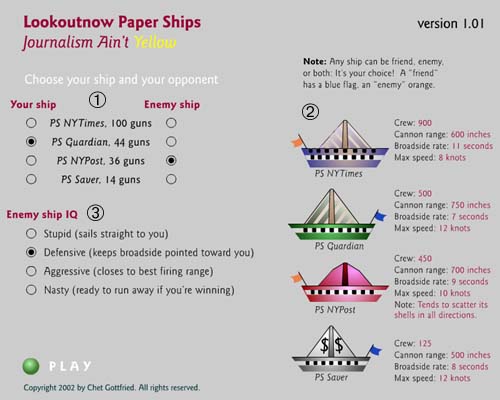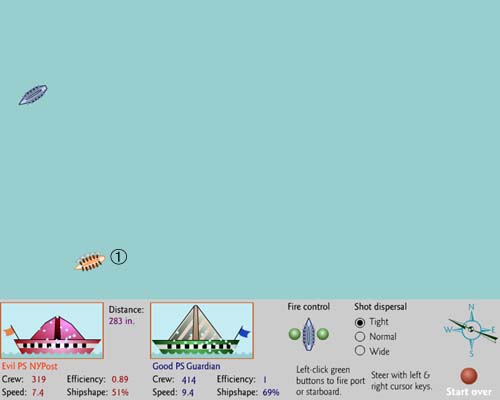| |
12 Dec. 2010: The game is freeware. Enjoy.
12 Dec. 2004
I should update the screen shots, since the online version now features eight ships. Also, I've added a fifth mode (to have an enhanced enemy), as well as a few other odds and ends.
After the opening digression, the game is explained via three screen shots with circled numbers. Each number has its own corresponding numbered paragraph below the graphic.
A digression: Imagine folding pages from a newspaper into a paper ship. Such a ship would have the characteristics of its parent newspaper.
The New York Times becomes a majestic ship of the line, if somewhat slow and of limited range. The Guardian is designed as a heavy frigate, going its own way. The New York Post, obviously, is hysterical, and the typical penny, nickel, dime, or dollar savers are a class all their own.
The factors that went into transforming a newspaper or magazine into a sailing ship are totally subjective; no publication that I know of has approved (or tried) this approach.
You can play the game as a ship-against-ship contest or as a way of blasting an unfavorite newspaper out of the water.
The game size is 800 by 640 pixels.
|

|
| |
Options Page
- You choose your own ship and the your enemy’s ship. If you want an even match, you can choose the same ship twice. Your ship has a blue flag, the enemy an orange one.
- Here we have the general health appearance of a ship, as well as its prime characteristics. In addition to the number of guns (from the first list), the ships are rated by crew number, cannon range, rate of fire, and maximum speed. Note that the cannon range is optimum: a given broadside may fall short or run long.
- Match your playing style with enemy IQ. A stupid enemy sails straight toward you (which is a great way to practice raking tactics), but will sail away if having too much damage. The defensive enemy turns a broadside to you before reaching firing range; however, it won’t seek to run away if you try to close. An aggressive enemy approaches you till it is well within its ideal firing range; it won’t run away. The nasty enemy tries to stay on the edge of its firing range; it will run away if damaged too much.
The game has two active screens: an overall view (the strategic screen) and a closeup view (the tactical screen). (I dropped the boarding scenario in favor of collision damage.)
|

|
| |
Strategic Screen
- The overall pond in which all the action takes places, approximately 3000 by 1900 inches of maneuvering room. The line of mist around the border is an escape route, because once a ship disappears beneath the mist, the contest is a draw: one of you got away. However, within 320 inches of each other, both ships are taken to the tactical screen, out of which there is no simple escape via mist.
- Your ship, which is blue. The two ships appear 1000 inches apart. At random, your ship is either on the left with the enemy on the right or vice versa.
- The enemy ship, which is orange.
- The enemy ship’s profile. If the ship is hit by cannon fire, you will see the damage shown on this view. Below the profile are the ship’s name, active crew, current speed, efficiency, and overall well-being (or shipshape). If either the active crew or shipshape falls to zero, the enemy has been captured and/or sunk. Efficiency is a measure of the crew’s ability to handle the ship; if less than 80 percent of its original crew remain active, efficiency falls and trouble begins. For example, at an efficiency of .5, the ship sails half as fast and takes twice as long to reload its cannons.
- The current distance, in inches (these are newspaper-folded ships after all) between the two ships.
- Your ship's profile. It has the same information as described in item 4.
- The fire control. Left-click on the left green button to fire the port cannons or on the right to fire the starboard ones. (Port and starboard cannons are timed independently of one another). After you click to fire a broadside, the button turns red until the guns are reloaded (when the button is green again).
- Shot dispersal: a key element! Left-click to choose a tight, normal, or wide cannonball dispersal. If uncertain about aim, choosing normal or wide is fine; if you position your ship well, a tight broadside is devastating. (Note that the NYPost is hysterical: its "normal" broadside falls in a vast semicircle, and its tight broadside isn’t much better.)
If a cannonball hits, you’ll see (and hear) fire bursts on that ship; for misses, you’ll see (and hear) splashes in the water (unless the ball goes beyond the screen range). Your misses will give you valuable information on how to improve your shooting. For instance, if you see an arc of splash rings appear equally on both sides of your target, that’s the time to switch to tight broadsides.
- Wind direction. The direction is set at random at the start of a ship duel. Afterward wind may change in fits or bursts (which makes the weathervane handy), but none particularly large. The idea is to have a prevailing wind, even if you cannot count on it overly much. (Wind speed is constant . . . for now.)
- Steering. Steer with the left and right cursor keys. Left = port, right = starboard. Note: steering deteriorates on a badly damaged ship.
The "Start over" button on the right lets you leave a bummer situation.
The following shows the tactical screen (and only one circled number!). You reach it as soon as the two ships are 320 inches apart. The enlarged view allows easier ship maneuvers, but at this range, cannon fire is more destructive.
|

|
| |
Tactical Screen
- Smoke. At this range, shell splashes often end up off the screen, and if you ever wonder which cannons you actually used, smoke is a handy indicator. Whenever a broadside is fired, puffs of smoke come out of that side. Here, the enemy fired its starboard broadside.
(Sure you could fire both broadsides each time to make sure that at least one goes in the correct direction, but wouldn’t it be better to save that other broadside, swing around, and let that ship have it?)
For the tactical screen, the main point is that there is no running away. If either ship makes it to the screen edge and both ships are within 320 inches of each other, the two ships are recentered on the tactical screen. (If a ship makes it to the edge and the two are more than 320 inches apart, both ships are returned to and centered on the strategic screen. Then a run for the mist can begin in earnest.)
Winning
Sink the other newspaper's ship, because if your crew is blown away or your ship sinks, you lose. And no one wants that to happen!
Just remember, most newspapers live to print another day, and running away may be better than sinking. Or so I'm told.
Isn't time you set sail?
Paper Ships
|




